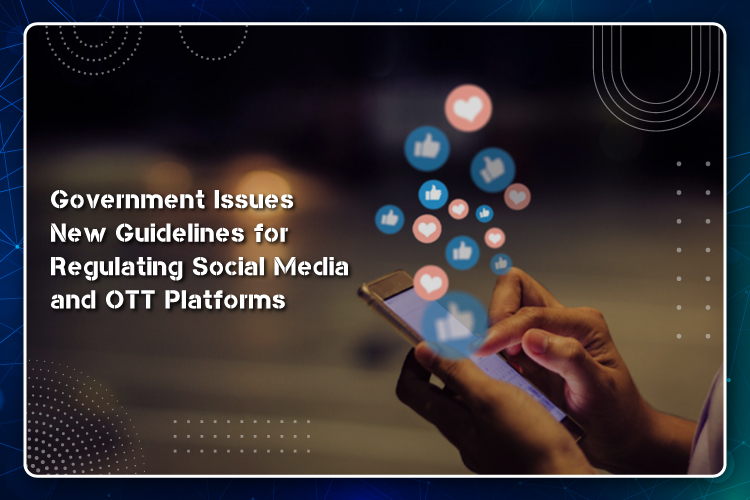Government Issues New Guidelines for Regulating Social Media and OTT Platforms

On Thursday, the Central Government issued new guidelines for the regulation of social media and OTT platforms to restrain the exploitation of content.
The Union ministers Ravi Shankar Prasad and Prakash Javadekar briefed the media, welcoming social media companies to operate and do business in India and applauding them for gathering such immense popularity and a good number of users. Moreover, they praised these platforms for empowering the average users with the power of technology.
However, the ministers said that the double standards of social media won’t be acceptable anymore and that regulating the actions of social networking companies in India has become crucial. These companies need to obey the Constitution and laws of India. To do so, the Centre has demanded the establishment of a quick grievance redressal mechanism.
Let’s take a look at the key takeaways from the media briefing.
Three-Tier Grievance Redressal Mechanism:
- A three-tier grievance redressal mechanism has been set up under the rules with two self-regulation levels.
- Level-I and level-II consist of self-regulation by the publishers and self-regulating bodies of the publishers, respectively. Level-III comprises an oversight mechanism formulated by the Ministry of Information and Broadcasting.
- Under the new social media regulatory mechanism, the significant social media intermediaries will have to appoint a Resident Grievance Officer, Nodal Contact Person, and Chief Compliance Officer.
- The self-regulatory body of the publishers shall be headed by a retired Supreme Court judge or High Court judge or by an independent eminent person.
- There might be more than one self-regulatory body, and such bodies will need to register with the Ministry of Information and Broadcasting.
Social Media Intermediaries:
- There will be two categories of social media intermediaries.
- The Centre shall declare the threshold of user base soon that will tell apart significant social media intermediaries from social media intermediaries.
- All intermediaries must establish a speedy grievance redressal mechanism and appoint a Grievance Officer who shall acknowledge the grievance within 24 hours and make sure to resolve it within 15 days of receiving it.
- The significant social media intermediaries will have to publish a compliance report every month stating the details of the grievances received and the action taken by them on those grievances, along with the details of the contents removed proactively.
Due Diligence to Be Followed by the Intermediaries:
- The person named as the Chief Compliance Officer will be responsible for ensuring compliance with the Acts and Rules and must be a resident in India.
- The appointed Nodal Contact Person shall be a resident in India and be responsible for coordinating with law enforcement agencies 24×7.
- The Resident Grievance Officer shall be a resident in India and perform all the functions stated under the grievance redressal mechanism.
- All significant social media intermediaries must have a physical contact address in India put out on their website and/or mobile app.
Reveal the Name of the First Originator of a Mischievous Message or Tweet:
- When asked by a government authority or court order, social media platforms will have to reveal the name of the first originator of a mischievous message or tweet, depending on the circumstances.
- However, this should be only regarding the sovereignty and integrity of India, public order, the security of the State, friendly relations with foreign States, or rape, child sexual abuse, and sexually explicit content.
Ensuring Online Safety and Dignity of Users, Especially Women:
- Intermediaries must disable access to or remove contents revealing the private parts of individuals, showing such individuals in partial or full nudity or in sexual acts or having the characteristics of impersonation including morphed pictures, etc., within the 24 hours of receiving the complaint.
Self-Classification of Content Into Five Age-Based Categories:
- The OTT platforms or publishers of online curated content will have to self-classify their content into five age-based categories, viz. U (Universal), U/A 7+, U/A 13+, U/A 16+, and A (Adult).
- All OTT platforms must apply parental locks for contents that are classified as U/A 13+ and higher and implement reliable mechanisms for age verification for contents that are classified as “A.”
Voluntary User Verification Mechanism:
- Social media platforms shall have a proper voluntary verification mechanism for users who wish to get their accounts verified.
- If significant social media intermediaries disable access to or remove any content shared by a user, they must send him/her a prior intimation with a notice clarifying the grounds and reasons for such action being taken. Also, the platforms should provide the users with a fair opportunity to be heard and dispute the action taken by the particular intermediary.
Wrapping It Up
The large-scale spread of the internet and smartphones has fueled the expansion of social media platforms in India. The Centre said that according to reports, the user base of major social media platforms in India currently stands at WhatsApp – 53 crores, Facebook – 41 crores, Instagram – 21 crores, YouTube – 44.8 crores, and Twitter – 1.75 crores. An elaborate version of these guidelines will be issued later, although no particular date has been mentioned yet. All rules will take effect from their publication date in the gazette. However, the additional due diligence for significant social media intermediaries will take effect three months after these rules are published, the Centre said.
